Related Research Articles
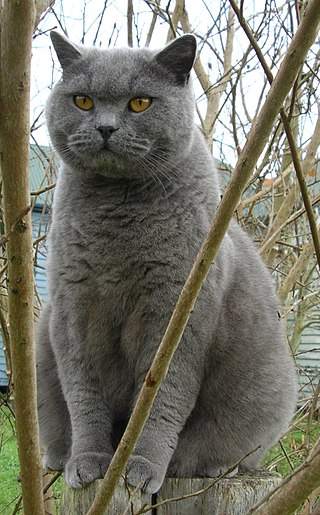
The British Shorthair is the pedigreed version of the traditional British domestic cat, with a distinctively stocky body, thick coat, and broad face. The most familiar colour variant is the "British Blue", with a solid grey-blue coat, pineapple eyes, and a medium-sized tail. The breed has also been developed in a wide range of other colours and patterns, including tabby and colourpoint.
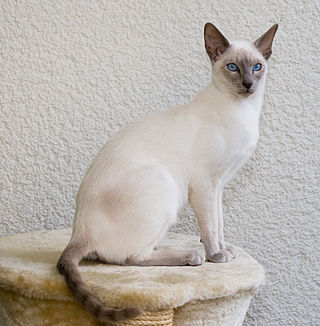
The Siamese cat is one of the first distinctly recognised breeds of Asian cat. Derived from the Wichianmat landrace, one of several varieties of cats native to Thailand, the original Siamese became one of the most popular breeds in Europe and North America in the 19th century. Siamese cats have a distinctive colourpoint coat, resulting from a temperature-sensitive type of albinism.

The Sphynx cat also known as the Canadian Sphynx, is a breed of cat known for its lack of fur. Hairlessness in cats is a naturally occurring genetic mutation, and the Sphynx was developed through selective breeding of these animals, starting in the 1960s.

The Russian Blue cat, commonly referred to as just Russian Blue, is a cat breed with colors that vary from a light shimmering silver to a darker, slate grey. The short, dense coat, which stands out from the body, has been the breed's hallmark for more than a century.

The Korat cat is a silver-tipped blue-grey, short-haired breed of domestic cat with a small to medium build and a low percentage of body fat. Its body is semi-cobby, and unusually heavy for its size. It is an intelligent and playful active cat that forms strong bonds with people and is very vocal, with a sound different from other breeds. Among the Korat's distinguishing characteristics are its heart-shaped head, its large green eyes. Its front paws are shorter than the back paws.

The Havana Brown was the result of a planned breeding between Siamese and domestic black cats, by a group of cat fanciers in England, in the 1950s. Early breeders introduced a Siamese type Russian Blue into their breeding. However, using current genetic testing, it is believed that almost none remain in the gene pool.
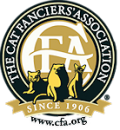
The Cat Fanciers' Association (CFA) was established in the United States in 1906. The CFA is currently the world's largest registry of pedigreed cats. Originally headquartered in Manasquan, New Jersey, the CFA moved to Alliance, Ohio in 2010. The association's stated mission is preserving and promoting pedigreed breeds of cats while also enhancing the well-being of all cats. CFA's first licensed cat shows were held in Buffalo, New York and Detroit, Michigan in 1906. The association today has a known presence in Europe, China, and Japan along with its well-established activity in the United States and Canada.

The Oriental Shorthair is a breed of domestic cat that is developed from and closely related to the Siamese cat. It maintains the modern Siamese head and body type but appears in a wide range of coat colors and patterns. Like the Siamese, Orientals have almond-shaped eyes, a triangular head shape, large ears, and an elongated, slender, and muscular body. Their personalities are also very similar. Orientals are social, intelligent, and many are rather vocal. They often remain playful into adulthood, with many enjoying playing fetch. Despite their slender appearance, they are athletic and can leap into high places. They prefer to live in pairs or groups and also seek human interaction. Unlike the breed's blue-eyed forebear, Orientals are usually green-eyed. The Oriental Longhair differs only with respect to coat length.

The Siberian is a centuries-old landrace of domestic cat in Russia, and recently developed as a formal breed with standards promulgated the world over since the late-1980s. Since 2006, the breed is recognised for registry and championship status with all major cat registries.

The Chausie is a domestic breed of cat that was developed by breeding a few individuals from the non-domestic species jungle cat to a far greater number of domestic cats. The Chausie was first recognized as a domestic breed by The International Cat Association (TICA) in 1995. Within the domestic breeds, the Chausie is categorized as a non-domestic hybrid source breed. Because Chausies are mostly descended from domestic cats, by about the fourth generation they are fully fertile and completely domestic in temperament.

The Donskoy cat, also known as Don Sphynx or Russian Hairless, is a hairless cat breed of Russian origin. It is not related to the better-known Sphynx cat whose characteristic hairlessness is caused by a recessive mutation in the keratin 71 gene. The Donskoy's hairlessness, on the other hand, is caused by a dominant mutation.
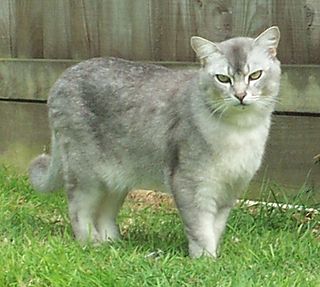
The Burmilla is a breed of domestic cat, that originated in the United Kingdom in 1981. It is a cross between the Chinchilla Persian and Burmese cats. In certain cat registries the breed falls under the Asian group, and is sometimes referred to as the Asian Shaded. Standards were produced in 1984, and the breed gained championship status in the United Kingdom in the 1990s.
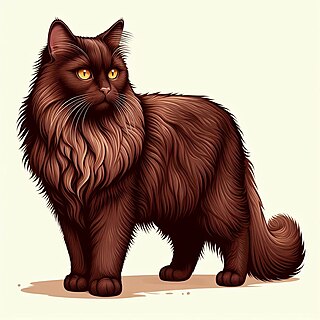
The Chantilly-Tiffany or Chantilly/Tiffany, also known as the Chantilly or the Foreign Longhair, was a breed of domestic cat which originated in the late-1960s in North America. The Chantilly breed never got off the ground and has always been rare. It was near-extinction in the late-1980s and again in the late-2000s. Since 2015 the breed was considered extinct with the passing and neutering of the last two cats of Chantilly lineage, and with no intact Chantilly cats the inevitable resulting discontinuation of the breeding program. However, new sightings of the Chantilly have been reported in the United States, disproving their extinction classification.

The International Cat Association (TICA) is considered the world's largest genetic cat registry. Originally a North American organization, it now has a worldwide presence. The organization has a genetic registry for pedigreed and household pet cats and is one of the world's largest sanctioning bodies for cat shows.

The Savannah is a breed of hybrid cat developed in the late 20th century from crossing a serval with a domestic cat. This hybridization typically produces large and lean offspring, with the serval's characteristic large ears and markedly brown-spotted coats. F1 and F2 male Savannahs can be very large, and in 2016 an F2 male attained a world record for tallest cat at 48.4 centimetres (19.1 in). Show-eligible F4–F5 cats range from 5.0 to 8.2 kilograms however, comparable in size to other large domestic cat breeds such as the Maine Coon or Norwegian Forest cat.

The Peterbald is a hairless cat breed of Russian origin. It was created in St. Petersburg in 1994 from an experimental cross of a Don Sphynx and an Oriental Shorthair. They have an Oriental build with a dominant hair-losing gene. The breed was accepted for Championship status in 2009.

The German Rex is a breed of domestic cat.

A calico cat is a domestic cat of any breed with a tri-color coat. The calico cat is most commonly thought of as being 25% to 75% white with large orange and black patches; however, they may have other colors in their patterns. Calicoes are almost exclusively female except under rare genetic conditions.

An Oriental bicolour is any cat of Oriental type, either long-haired or short-haired and in any pattern including colourpoint, which has white areas on its coat caused by the white spotting gene. In most cat fancier and breeder organisations, Oriental bicolours do not constitute a standardised breed, but a coat pattern variant of the breed of their foundation stock. One breed registry is an exception, the UK-based Governing Council of the Cat Fancy (GCCF), which has defined them as a separate breed named Oriental Bicolour (capitalised).

The Brazilian Shorthair is a breed of cat. It is the first cat breed from Brazil to receive international recognition.
References
- ↑ Full Mavis Jones article
- ↑ "This document can be viewed at this site" (PDF). Archived from the original (PDF) on 2007-09-30. Retrieved 2007-08-01.